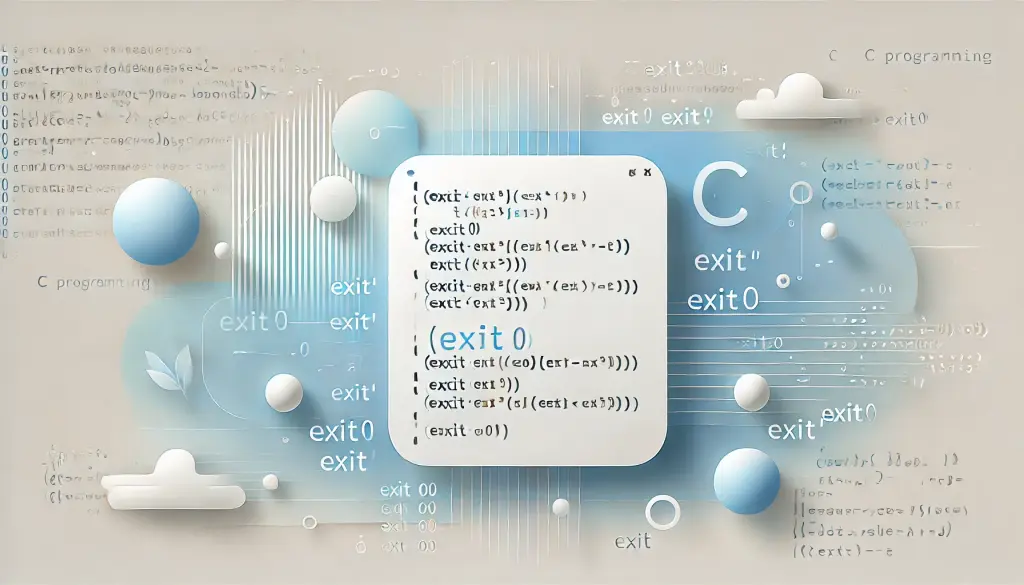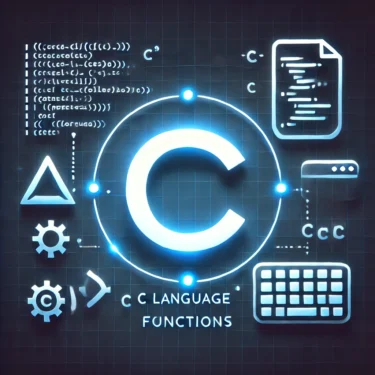1. Overview of the exit Function in C Language
In C programming, the exit function is used to explicitly terminate a program. Especially in large-scale applications or systems where error handling is critical, properly using the exit function allows you to clearly communicate the program’s termination status to the operating system. This article explains the basics of the exit function, its usage, and details the differences between exit, return, and abort functions.
Basic Syntax and Behavior of exit
The exit function is provided by the standard library and is used with the following syntax:
#include <stdlib.h>
int main() {
// Exit the program normally
exit(0);
}Since the exit function is defined in the stdlib.h header file, it must be included. This function returns a specified exit code, notifying the operating system of the program’s termination status.
Main Uses of exit
exit(0)indicates that the program has terminated successfully. It is used when everything runs as expected.- A nonzero value like
exit(1)indicates that the program has ended abnormally, such as when an error occurs.
2. Difference Between exit(0) and exit(1)
Exit codes in C are important for letting the system know how a program ended. Understanding the difference between exit(0) and exit(1) is fundamental for correct error handling.
exit(0) – Indicates Successful Completion
exit(0) means the program has completed successfully. For example, it is used when all processing finishes without any issues:
#include <stdlib.h>
int main() {
// If everything is successful
exit(0); // Normal termination
}exit(1) – Indicates Abnormal Termination
On the other hand, exit(1) means the program encountered an error and is terminating. Use exit(1) to indicate abnormal termination when resources are insufficient or a file fails to open, for example.
#include <stdlib.h>
int main() {
if (/* error occurred */) {
exit(1); // Abnormal termination
}
}Using EXIT_SUCCESS and EXIT_FAILURE
For better code readability, it is recommended to use EXIT_SUCCESS (for normal exit) and EXIT_FAILURE (for abnormal exit), both defined in the standard library.
#include <stdlib.h>
int main() {
if (/* success */) {
exit(EXIT_SUCCESS); // Success
} else {
exit(EXIT_FAILURE); // Failure
}
}3. Difference Between exit and return
Both the exit function and the return statement in C are used for program or function termination, but their usage and behavior differ. Understanding these differences enables proper termination handling.
Role of the return Statement
The return statement ends a function and returns a value. In the main function, using return will terminate the program and return the exit code to the system. However, return may not perform necessary cleanup (such as closing files or freeing memory) automatically.
int main() {
return 0; // Normal exit
}Role of exit
The exit function terminates the entire program, and unlike return, it automatically performs cleanup such as closing open files and running functions registered with atexit.
#include <stdlib.h>
int main() {
exit(0); // Normal exit with cleanup
}When to Use exit vs return
return is generally used for exiting within functions, while exit is used to forcibly terminate the entire program or for error handling in exceptional situations.

4. Advanced Usage of the exit Function
The exit function is useful in various scenarios beyond simple program termination. It is particularly powerful for error handling and resource management.
exit for Error Handling
When file operations or memory allocation fail, you can use the exit function to immediately terminate the program and notify the system or user about the error.
#include <stdio.h>
#include <stdlib.h>
int main() {
FILE *file = fopen("example.txt", "r");
if (file == NULL) {
perror("Failed to open file");
exit(EXIT_FAILURE); // Abnormal exit on error
}
fclose(file);
exit(EXIT_SUCCESS); // Normal exit
}Releasing Resources with exit
Using the exit function ensures that resources (like memory and files) are automatically released when the program ends, helping prevent resource leaks from unclosed files or unfreed memory.
5. Difference Between exit and abort
C also provides the abort function, which forcibly terminates a program abnormally. Unlike exit, abort does not perform cleanup—it ends the program immediately.
Overview of the abort Function
The abort function is used to immediately notify the system of a fatal error by sending the SIGABRT signal, forcibly terminating the program.
#include <stdlib.h>
int main() {
// Force terminate on a critical error
abort();
}Difference from exit
While exit performs normal cleanup and manages program termination gracefully, abort ignores cleanup and forcibly ends the program. Therefore, abort is typically used in the event of unrecoverable errors.
6. Summary
The exit function in C plays a crucial role in managing program termination. This article covered the basics of exit, its differences from return and abort, as well as advanced usage examples.
Review of the exit Function’s Role
The exit function notifies the system of the program’s termination status. exit(0) means normal completion, while exit(1) or other nonzero exit codes indicate abnormal termination. Using EXIT_SUCCESS and EXIT_FAILURE improves readability and helps manage the program’s lifecycle.
Choosing Between Functions
When to use exit or return depends on your program’s size and objectives. return is best for ending function execution, while exit is used to terminate the entire program. abort is used for critical situations when immediate termination without cleanup is needed.
Best Practices for Program Termination
It’s important to release resources—such as freeing memory and closing files—when a program ends. Using exit ensures cleanup is performed automatically, reducing the risk of resource leaks. This is especially important in large-scale or system-level applications.
Applying What You’ve Learned
By understanding how to use the exit function and the differences among various termination methods, you can create more stable and efficient C programs. Proper use of exit codes and handling abnormal termination are fundamental to writing robust code.





